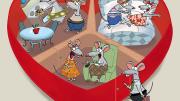What do Darwin’s finches and cichlid fish have in common? Both animals provide intense parental care, which appears to influence their offspring’s mating preferences later in life. In recent decades, scientists have proposed this “sexual imprinting” as one of the main mechanisms that drive explosive speciation within these groups: rapid branching in the tree of life.
Sexual imprinting has been observed in 15 orders of birds, some fish, and a few mammals. Now two species of deer mice (the most abundant mammal in North America) can be added to the list, according to a new paper in Evolution by Emily K. Delaney, Ph.D. ’14, and Hopi Hoekstra, Agassiz professor of zoology: the white-footed mouse (Peromyscus leucopus), and the cotton mouse (Peromyscus gossypinus). Known to produce viable hybrid offspring, these “sister species” have genetic markers suggesting that they diverged relatively recently—they’re at what Hoekstra calls the “sweet spot” for scientists interested in speciation.
While working in Hoekstra’s lab, Delaney (now an evolutionary geneticist at the University of California, Davis) planned to study a natural population of hybrids in the field, thinking she might examine the pheromones involved in mating. But the best-laid schemes of scientists often go awry: out of 316 wild mice that she collected and ran through genetic analysis, only 5 potentially fit the profile for hybrids. She therefore switched the focus of her project. The two species mate successfully in the lab—so why not in nature, when they’re running around in the same plot of woods?
To find out, she raised some mouse pups normally—weaned from their parents 23 days after birth and separated into same-sex cages. Other newborn litters were swapped into nests of nursing females of the opposing species. When it came time to test all the newly mature adults’ sexual preferences, she tried to make courtship conditions as natural as possible. Generally, past rodent mate-choice studies tethered the two “stimuli”—one mouse from each species—at either end of a Y-shaped chamber, with a third “chooser” mouse in the middle, but Delaney explains that this set-up tended to stress the mice out. She “needed something that would allow the mice to physically interact, but that would still contain the two stimuli mice.” So she devised an apparatus she privately nicknamed “the love box”: three chambers, with the male or female chooser in the middle and a suitor off in each wing, separated by gates pre-programmed to let only the chooser move freely. This allowed a wider range of interactions between chooser and candidates: fighting, chasing, nesting, copulation—all of it recorded on video.
By comparing the preferences of cross-fostered with native-raised mice, the researchers found that same-species preferences are largely determined by sexual imprinting. In other words, cotton and white-footed mice choose not to mate with each other in the wild due to learning, rather than genetics. But the degree of imprinting differs by species, and within that, by sex. Cotton mice preferences can be easily altered by cross-raising them: in adulthood, they will mate with a member of their foster species. In white-footed mice, though, only males seem to sexually imprint on their parents, whether native or foster; females’ preference for their own species remains constant regardless of who raised them. In the paper, Delaney and Hoekstra suggest that female white-footed mice might imprint on their male siblings (rather than parents), or that any nest-instilled preference for the foster-parent species might switch after they interact with the two candidates—especially, say, if the white-footed male seems receptive while the cotton mouse male wants to fight.
What makes offspring imprint? “That’s the next question,” says Hoekstra. In Darwin’s finches, for example, females pair with males that sing songs like their fathers’. In cichlids from Lake Victoria, females pick either red or blue mates based on the mothers who brooded them in their mouths, and scientists think that they’re following either color or chemical signals.
Delaney has a hunch about the mechanism in deer mice: “I’m almost certain that it’s going to be at least somewhat based on olfaction.” In a follow-up study, she tinkered with potential imprinting cues by raising some litters with parents who drank orange-flavored water, and others with parents who drank garlic-flavored water. Testing their mate choices (aided again by the “love box”), she found evidence for “diet-based assortative mating”—females in particular seemed to strongly prefer males on the same diet as their parents. Something about what their parents ate—possibly changing the odors of their saliva or waste, or just the general smells of the nest—impressed on offspring, who then used that information in adulthood.
Delaney and Hoekstra’s research adds to a sharpening portrait of speciation, and the impact of behavior like sexual imprinting. But the paper also clears up a question that had dogged mammalian ecologists for some 75 years: why cotton and white-footed mice won’t mate in nature, but will in captivity. What’s fun, says Hoekstra, is that with new molecular tools, and an assist from “this newfangled mate-choice apparatus,” scientists can elucidate “this age-old mystery in the field.”









